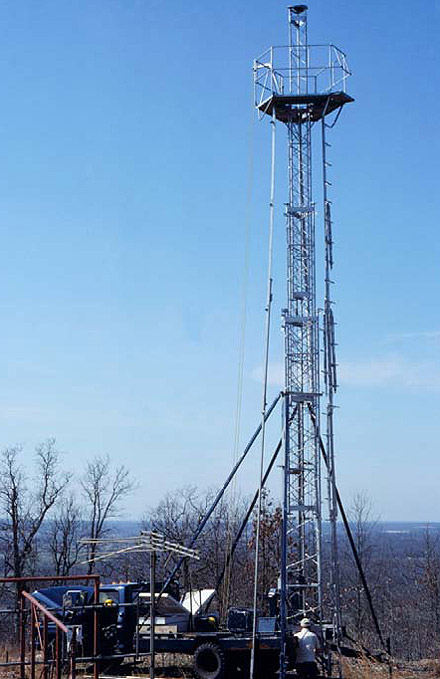Truck Mounted Observing Tower
The Truck Mounted Observing Tower, or "TMOT," was designed and built by the National Geodetic Survey in the 1970s to increase the efficiency of surveying. Once erect, the tower reached a height of 50 feet.

Several truck and trailer mounted towers were designed and built by the National Geodetic Survey's Instrument and Methodology Branch at Corbin, Virginia. The first such tower was built in 1969. The tower shown in the image above is a Truck Mounted Observing Tower, or TMOT, designed and built in October of 1976, by Ralph Penkenpaugh, Jerry Pryor, and George Lesley.The National Geodetic Survey also purchased several towers.
These towers were built or purchased in an effort to make surveys faster and cheaper. The TMOT could raise a surveying instrument or signal to a height of 50 feet and could be erected by two people in about half a day. This rapid assembly was possible because many of the pieces were pre-assembled and because most of the weight of the tower was raised hydraulically.
Assembling the TMOT
The TMOT was mounted on a flat-bed truck. The truck was driven to the survey site and situated so that the tower, when erected, would be directly over the survey mark. While traveling, the TMOT was in a horizontal position. After correct positioning, tower parts were added, including the observing cage. Hydraulic power was then used to rotate the tower to the vertical position. The tower was then telescoped to a height of 50 feet, the outer tower being carried up by the inner tower. After reaching full height, the outer tower was separated from the inner tower and cross-bracing added to make the outer tower stiff and independent.
The tower was limited by needing truck access to the survey mark, by the small observer platform, and by a 50-foot maximum height. Still, erecting the tower took less labor and time than a Bilby Tower.
- Tower shown: Truck Mounted Observing Tower
- Approximate dates of use: 1976 to 1984
- Average height: 50 feet
- Materials of construction: Steel/metal
- Unique features: Could be erected using hydraulics in less than half a day by two people.

 Timber Tower
Timber Tower Dimensional Lumber Tower
Dimensional Lumber Tower Pipe Tower
Pipe Tower Bilby Tower
Bilby Tower Peck Tower
Peck Tower Four-foot Stand
Four-foot Stand Truck Mounted Observing Tower
Truck Mounted Observing Tower G-Tower
G-Tower Trailer Mounted Tower
Trailer Mounted Tower Swedish Pole
Swedish Pole